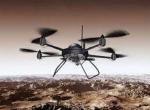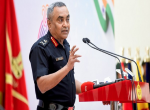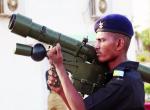Five months after India’s successful test launch of the 3,500 km range Agni-IV ballistic missile, the well over 5000 kms range Agni-V was successfully test fired at 08:07 hours on 19 April 2012 from the Wheeler’s Island , Odisha.
Planned for a night launch on the evening of 18 April, but postponed owing to bad weather, the missile, according to Defence Research and Development Organisation (DRDO) was flawlessly auto-launched the next morning, rising exactly the way it was designed for. It followed the entire trajectory in DRDO’s favourite phrase “in textbook fashion” with the three stages of propulsion dropping and falling at appropriate times into Bay of Bengal. The three propulsion stages, developed completely indigenously by DRDO, performed exactly the way they were intended to and the indigenously developed Composite Rocket Motors have performed well. All the radars and electro-optical systems along the path monitored all the parameters of the missile and displayed in real time. Ships located in midrange and at the target point tracked the missile’s flight.
Lot of new technologies developed indigenously were successfully tested in this Agni-V Mission. The redundant navigation systems, very high accuracy Ring Laser Gyro based Inertial Navigation System (RINS) and the most modern and accurate Micro Navigation System (MINS) ensured the missile reach the target point within few meters of accuracy. The high speed onboard computer and fault tolerant software along with robust and reliable bus guided the missile flawlessly.
“DRDO Scientists have made the country proud” said Prime Minister Dr. Manmohan Singh while speaking to Dr V.K. Saraswat, the Scientific Advisor to the Defence Minister and Programme Director Avinash Chander and congratulated all the Scientists of DRDO. Defence Minister A.K. Antony was monitoring the launch activities and immediately after successful flight, congratulated all the Scientists on this much awaited event. National Security Advisor Shiv Shankar Menon congratulated DRDO Scientists and said that the event is a milestone in the long range Missile era of India. Air Marshal K.J. Mathews, C-in-C Strategic Forces Command, who witnessed the launch, said that the success of AGNI-V is historical event for India.
Agni-V is a solid fuelled long range ballistic missile developed by DRDO and will greatly extend India’s reach to strike targets well beyond 5,500 km. It will be quite easy to store and swiftly transport the missile by road since it's a canister-launch missile system, unlike the earlier Agni missiles. Agni-V would also carry MIRV (multiple independently targetable re-entry vehicles) payloads being concurrently developed. A single MIRV equipped missile can deliver multiple warheads at different targets. With a ‘launch mass’ of around 50 tonnes and a development cost of over Rs 2,500 crore, Agni-V will incorporate advanced technologies involving ring laser gyroscope and accelerometer for navigation and guidance. It takes its first stage from Agni-III, with a modified second stage and a miniaturised third stage to ensure it can fly to distances of 5,000 km. With a canister-launch system to impart higher road mobility, the missile will give the armed forces much greater operational flexibility than the earlier-generation of Agni missiles. According to a source, the accuracy levels of Agni-V and the 3,500-km Agni-IV (first tested in November 2011), with their better guidance and navigation systems, are far higher than Agni-I (700-km), Agni-II (2,000-km) and Agni-III (3,000-km).
Chinese media controlled by the Communist Party of China was full of this news. While a section of it did not consider it significant, the Global Times, a one of the prominent Chinese newspaper cites Agni-V launch just as an addition to promote the arm race in Asia and warned India not to compete with China. Global Times is the Chinese newspaper that publishes views on the behalf of Communist Party of China. Chinese diplomats, however, did not give any such sharp reaction to the test. Chinese Foreign Ministry spokesman Liu Weimin, stated that India and China are both emerging countries and expressed hopes that both the countries work together to maintain a peaceful environment. However, nestled within the response, Liu included a subtle reference to the conflict, saying ‘we should both cherish the fact that our current good relations were hard to come by.’ However, the fact remains that China’s periodic outbursts, claims, incursions, activities, postures etc on the ground in Arunachal Pradesh and other parts of the Line of Actual Control and most importantly, its very substantial nuclear arsenal, its strong military ties with Pakistan in conventional and nuclear fields and its deployment of a division strength of troops in Pakistan Occupied Kashmir is far from reassuring.
By this successful test of Agni-V, now India has joined the elite club of countries with the United States, Russia, and China. While it is a commendable achievement in for India in developing the technology, it will amount to strategic deterrence only after production and deployment.
On countries pontificating about India’s nuclear tests leading to or adding to an arms race in the subcontinent, it needs to be clarified that India as one of the greatest votaries of non-nuclearisation was left with no choice but to nuclearise in view of Pakistan’s and China’s nuclear programmes. And in any case, who are the original proliferators of nuclear weapons creating conditions for mutually assured destruction? Which is the country that actually started this race and which is the country to have actually launched a nuclear attack?
Although unconfirmed, most Western analysts believe China has deployed anywhere from 18 to 36 Dongfeng 5 (East Wind) intercontinental ballistic missiles (ICBM) since the 1980s. The Dongfeng 5A is a single-warhead, three-stage, liquid-fueled missile with a range of over 13,000 km. In 2000, General Eugene Habiger of the U.S. Air Force, then commander of the U.S. Strategic Command, testified before Congress that China has 18 silo-based DF-5s. Since the early 21st century, the Chinese People’s Liberation Army’s Second Artillery Corps also deployed up to 10 solid-fueled mobile DF-31 ICBMs, with a range of 7,200+ km and possibly up to 3 MIRVs. China has also developed the DF-31A, an intercontinental ballistic missile with a range of 11,200+ km with possibly 3-6 multiple independently targetable reentry vehicle (MIRV) capability. China reportedly stores many of its missiles in huge underground tunnel complexes. US Representative Michael Turner referring to 2009 Chinese media reports said “This network of tunnels could be in excess of 5,000 kilometers (3,110 miles), and is used to transport nuclear weapons and forces.” he Chinese Army newsletter calls this tunnel system an underground Great Wall of China. Approximately 55 percent of China’s missiles are in the medium range category, targeted at regional theater targets. The Chinese categorize long range ballistic missiles as ones with a range between 3000 to 8000 km.
The use of rockets and missiles by Indians dates back to 18th century, i.e. during the period of ruler Hyder Ali and Tipu Sultan. They used rocket artillery brigades against infantry formations for mass attacks. The rocket men were trained to launch the rockets at a launch angle which was calculated from the diameter of the cylinder and the distance of the target. The launchers were having the capability to launch 5-10 rockets in salvo firing mode. Tipu Sultan had 27 brigades and each brigade had a company of rocket men. With such a huge force, he defended the Mysore kingdom against the British until his death at Srirangapatnam in 1799. Even, Marathas used the rockets at the Battle of Panipat in 1761. With the death of Tipu Sultan, Indian rocketry also met its demise, only to be revived in the 1970s by Drs. Vikram Sarabhai, APJ Abdul Kalam, and others. Two of the rockets, captured by the British at Srirangapatnam, are displayed in the Royal Artillery Museum in London.
Defence Science Organization, formed in 1956 for initiating studies & development of work on futuristic weapon systems was headed by Dr. B. N. Singh who formed the Special Weapon Development Team (SWDT) study and development of guided missiles. At Metcalfe House, Delhi the Team worked on a 1st generation Anti-Tank Missile (ATM) for gaining developmental experience. SWDT became Defence Research & Development Laboratory (DRDL) at old Ahmed Manzil, Hyderabad, in June 1962 under Gp. Capt. V Ganesan its Director. A project formulated at DRDL in 1964 got support of Army after the 1965 Indo-Pak war and got converted to a “Staff Project”, which tested an indigenously developed anti – tank missile in 1970, considered as a major achievement by DRDL, which later moved to the Defence Research Complex at Kanchanbagh, on the periphery of Hyderabad's Old City. Some scientists and Army, Navy and Air Force officers developed the DEVIL missile.
All the preliminary understanding and development of Electronics sub-systems of DEVIL missile including Airframe and Aerodynamics were carried out at Ahmed Manzil. Leading scientists like Mr.Burman, Mr. JC Bhattacharya, Admiral Mohan and Mr. Surya Kantha Rao gave thrust to Electronics, Navigation, Guidance & Control and Telemetry & Instrumentation areas. Dr. Ranga Rao, Dr. Rama Rao, Dr. Bala Krishnan, Mr. Krishnan, and Dr.Achyuthan gave priority to Airframe, structures, Aerodynamic and system related areas. This was further strengthened by the techno-managerial leadership of Lt.Gen.(Retd) Dr. VJ Sundaram, Lt.Gen.R.Swaminathan and Squadron Leader Shah in the area of airframe controls and integration.
Rocket Test House (RTH, Presently near Kanchanbagh) was identified for carrying out propulsion related design and tests. The liquid and solid propulsion areas were continuing with vibrant leadership of Dr. Gopal Swamy and Wg. Cdr. Sen. Re-entry technology and ballistic missile programmes were spearheaded by Shri R.N. Agarwal. The state-of-the-gyro test facility was initiated by Mr. P. Banerjee within the campus. However, the whole facility of Ahmed Manzil was shifted near Kanchanbagh in 1975. Full scale missile laboratory (DRDL) was built up from then onwards.
The Integrated Guided Missile Development Program (IGMDP) under India’s Defence Ministry, began since early 1980s for the development of a comprehensive range of missiles, including the intermediate range Agni missile (Surface to Surface), and short range missiles such as the Prithvi ballistic missile (Surface to Surface), Sagarika, the naval version of the Prithvi, Akash missile (Surface to Air), Astra missile (Air to Air), Trishul missile (Surface to Air), Nag Missile (Anti Tank) and also an inter-continental-ballistic-missile (codenamed Surya missile) with a range of 8,000-12,000 km. Managed by DRDO in partnership with other Indian government labs and research centres, one of the most prominent chief engineers on the project, Dr. Abdul Kalam went on to become the President of India.
In 1998, the Government of India, signed an agreement with Russia to design, develop, manufacture and market BrahMos (Brahmaputra –Moscow rivers), a Supersonic Cruise Missile System that can be launched from submarines, ships, aircraft or land, which was successfully accomplished by 2006. At speeds of Mach 2.5 to 2.8, it is the world's fastest cruise missile, about three and a half times faster than the American subsonic Harpoon cruise missile. BrahMos is reportedly attempting a hypersonic Mach 8 version of the missile, BrahMos II, the first ever hypersonic cruise missile, expected to be ready by 2012-13.
While India must forge ahead with production of its missiles, it must not neglect regaining and maintaining its edge in conventional weapons, on which it is at an all time low. Further, India must also shake out of its known mode of a soft state and strive to develop the political will to acquire the requisite level of force and send the message that it will effectively be used.
Published Date: 16th May 2012






.jpg)


Post new comment